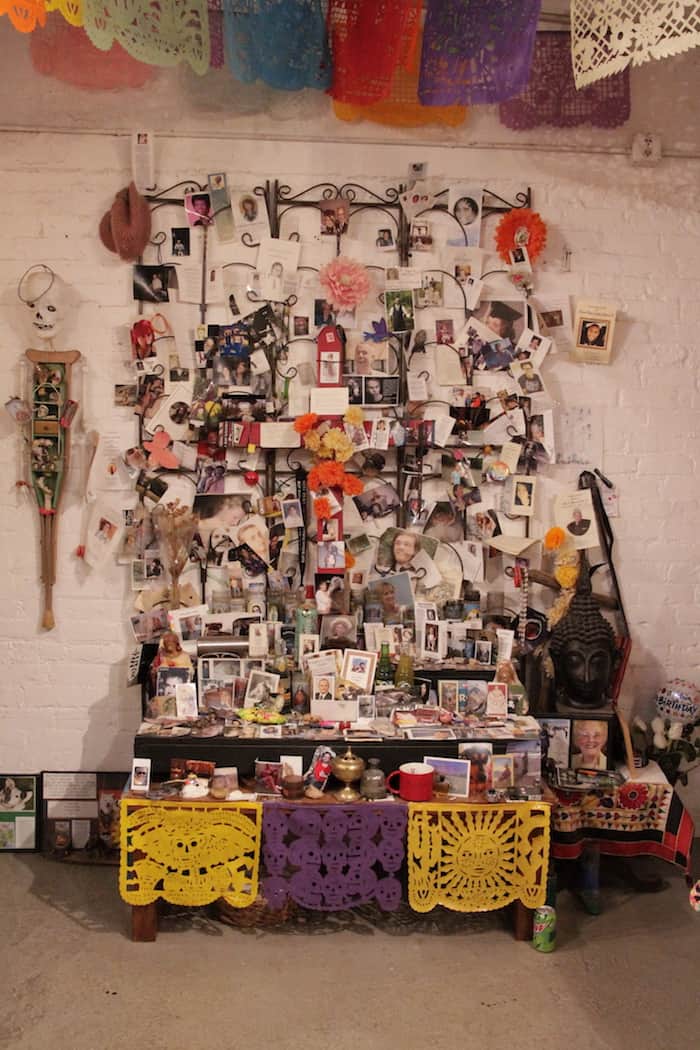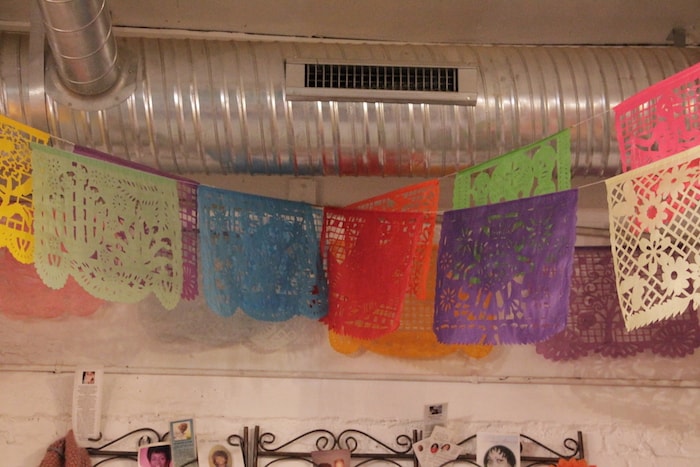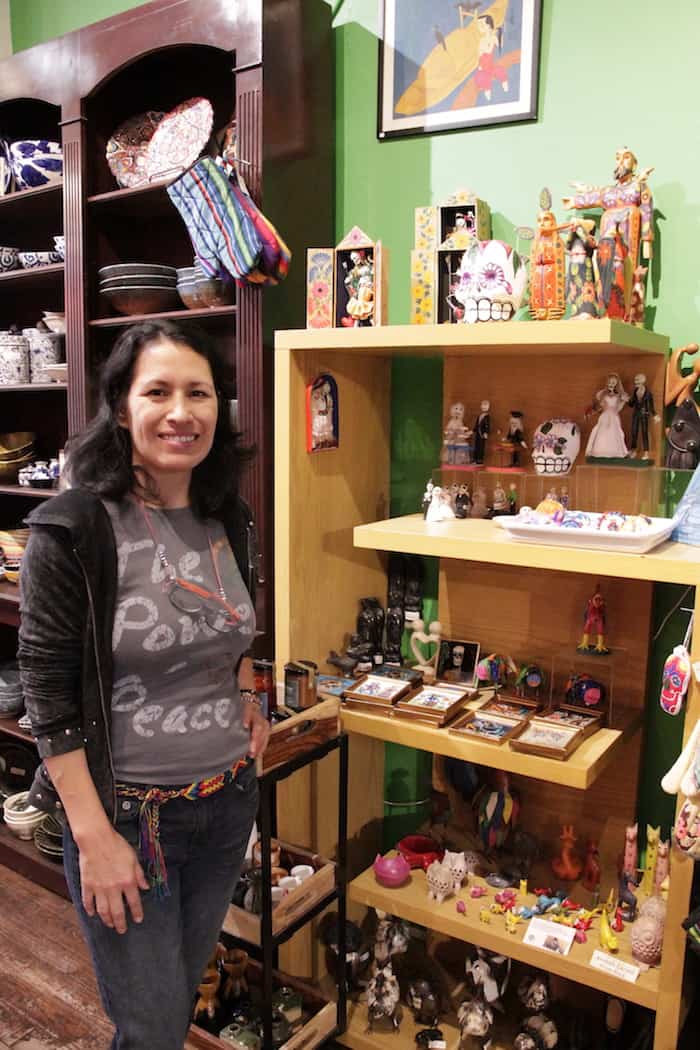
Día de los Muertos, or Day of the Dead, is a Mexican tradition that has taken hold in the United States.
Different interpretations of it are celebrated in schools, bars, museums and restaurants.
For an authentic Day of the Dead experience, visit Pura Vida Worldly Art, 3202a N. Davidson Street, in NoDa. Pura Vida is a shop that features both local art and handmade, fair trade items from around the globe.
At Pura Vida, you can bring a picture of a loved one that you want to remember and celebrate, and put that picture up in the altar that’s in the store all year.
You can come in with your photo or memento any time the store is open. Find the current hours here.
Also, you can purchase special papel picado (chiseled paper) for Day of the Dead at Pura Vida. In the picture below, you’ll see the Day of the Dead papel picado behind the everyday papel picado, and you can also see it on the bottom of the altar, pictured above.

You can also purchase copal and the charcoal to burn at home, a Mexican tradition. Pura Vida always carries beautiful handmade Day of the Dead folk art, earrings and coffee mugs.

While you’re there, you can ask Teresa Hernández, the owner of Pura Vida, questions about the traditions of Day of the Dead, and she’ll be happy to answer.
I asked Teresa about the altar in the shop, about how her family in Mexico celebrated Day of the Dead, and how she thinks we can all benefit from participating in the tradition. (Note: Interview is from October, 2018.)

Q: First, would you call this an observance or a celebration?
A: I’d call it an experience. Because even if they don’t bring something, they’re still taking in everything that’s here. People do it all the time because we keep it (the shrine) all year round. We’ve had it for over a decade. We always invite people to bring pictures or mementos. They can do that any time of year. And during Day of the Dead we’re inviting them to bring flowers. If they want to bring food and drink they can do that as well. We’ll leave it up for those couple of days. And then after that we’ll put the food and the drink away. We’ll leave the flowers until they die. And of course if they want to bring pictures they can. We’ll always make room for them.
And I’ll be here, so if they want to learn more about the tradition of creating an altar and what people do in different places I’d be glad to talk to them about it.
Q: Can you tell me about copal?
A: In the U.S. people burn sage. In Mexico we burn copal. Copal is what all the shamans use. When you get a cleansing from a shaman, because they think you’ve got a spell, or in the churches, this is what they use. It’s similar to frankincense and myrrh, in that it creates a feeling of love and healing and safety. So that’s what we burn.
Q: So you’ll have that burning both days?
A: Right.
Q: And that’s something that normally you don’t have at the altar? It’s special for Day of the Dead?
A: Yes, it’s a little smoky so I wouldn’t do it every day. It’s also specific to Mexico.
Q: What part of Mexico are you from and how long have you been in the United States?
A: I’m from San Luis Potosí and my family celebrated Day of the Dead big. I moved to the U.S. when I was five. My family in Mexico still celebrates it. For them it’s a very spiritual holiday, not so much the parades that you see on TV in the big cities in the U.S. like San Francisco. Where I’m from, it’s a small farm town, so it’s really all about the dead, not so much all this other stuff. It’s about building a shrine to remember anyone that’s passed away. Like my grandmother, I lost her recently, a few months ago, but we had a big family. Obviously we’ve lost a lot of people because we had a big family, and to fit all the people she was remembering she put a textile up, flat against the wall, and just pinned everyone’s picture to it, because there wasn’t space. She’d light a candle for every person too, so she had to fit the candles and the food in too. And then we would pray a rosary every day a couple of weeks leading up to Day of the Dead.
Q: What are some misconceptions that people have about Day of the Dead?
A: There’s a lot of misconceptions. A lot of people think it’s like Halloween, in that they think it’s about dressing up and going parading. In some of the bigger cities they do have parades and people do dress up, but it’s really a very spiritual holiday.
A lot of people also think that it’s just a happy holiday. It’s actually somber and joyful. It’s somber because anytime you’re remembering someone you lost there’s going to be some sadness still. The joy comes in that typically you’re doing this thing for that person with other family members and friends and that brings in the joy. You start telling stories about the person. When my family would put up a shrine we were like “Do you remember, he liked this dish.” Or “He liked tequila, let’s put up a bottle of tequila.” So that makes it fun, and less sad. But it’s a very somber holiday.
Another misconception people have is because people will often stay in a cemetery for hours, sometimes all night, they think it’s a party. In my family, we do that too, but it’s not because we’re having a party there. It’s because you see so many people there you know. It’s like when you go the grocery store and you run into everyone and it takes you two hours to get out of Harris Teeter. It’s like that. You go to the cemetery and you see all your friends and you start talking to them and asking them, “Oh, who are you here to celebrate?” And you walk with them to their tombstone. And then you talk about that person. And you run into someone else and you go to their tombstone. Before you know it you’ve been there six or eight hours. But it’s all to celebrate the people that you’re there to visit. It isn’t a party.
Q: What do you think people can get from observing Day of the Dead, no matter what their background or belief system is?
A: I always tell my customers that having an altar for someone and going to it regularly, annually, or more often, I think it’s very healing. I think in the U.S., and I’ve been in the U.S. long enough to know, once a person is buried and gone, we’re expected to move on. And I think it’s very healing to grieve over and over again. And to openly remember that person with friends and family over and over again. And it doesn’t have to be complex. This is complex because it’s a community shrine, but a shrine can be as simple as having a picture of your grandmother, a flower for her, lighting a candle, and that’s it.
Q: Do you find it emotional to see all these faces?
A: All the time. I clean it once or twice a year because it does get dusty, and it takes four or five hours, because I make sure I put the pictures back where they were, and I sob. Every time I clean it. It is emotional because there’s a lot of love, and there’s also a lot of pain, with every picture.
Visit Pura Vida Worldly Art at 3202a N. Davidson Street. The altar is there all the time.
Subscribe to Charlotte on the Cheap
Evelyn says
Great article, well written and informative!